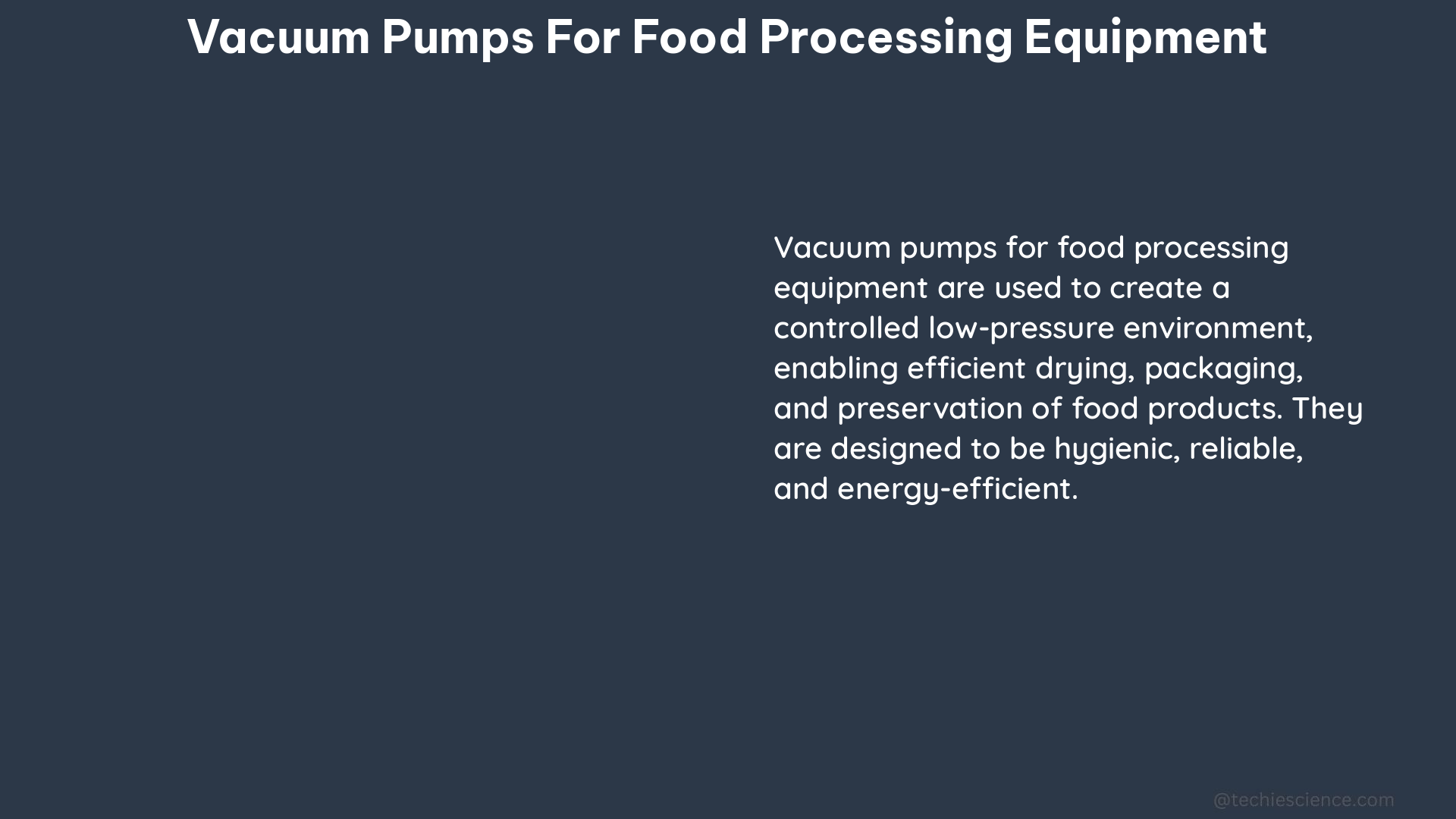Vacuum pumps play a crucial role in the food and beverage industry, contributing to various processes such as packaging, bottling, drying, and degassing. They help preserve meat products, fish, cheese, and other perishable items by extending their shelf life significantly. Vacuum cooking, following the sous vide concept, allows food to cook more evenly and retain more of its natural flavor and texture.
Understanding Vacuum Pump Requirements for Food Processing
When it comes to specific applications, vacuum pumps have different requirements:
Packaging
- Low pressure requirement, typically around 10-50 mbar (0.01-0.05 bar)
- Faster cycle time, usually less than 60 seconds
- Ensures airtight sealing and extends shelf life of packaged products
Processing (Tumbling/Mixing)
- Medium pressure requirement, typically 50-200 mbar (0.05-0.2 bar)
- Longer cycle time compared to packaging, often 2-10 minutes
- Facilitates even distribution of marinades, seasonings, or other ingredients
Freeze-Drying
- Lower pressure requirement, usually 0.1-10 mbar (0.0001-0.01 bar)
- Cycle times can vary depending on the product and process
- Removes moisture from the product while preserving its structure and flavor
Dry Vacuum Pumps: The Preferred Choice for Food Processing

In the food industry, dry vacuum pumps are increasingly replacing wet pumps due to their cleaner operation, efficiency, and improved sanitation:
| Characteristic | Dry Vacuum Pumps | Wet Vacuum Pumps |
|---|---|---|
| Heat Load | Lower | Higher |
| Power Consumption | Lower | Higher |
| Use of Oil and Water | No | Yes |
| Maintenance Protocols | Fewer | More |
| Repairs | Fewer | More |
| Efficiency | Peak | Lower |
| Heat Generation | Lower | Higher |
| Noise Levels | Reduced | Higher |
| Risk of Slip-and-Falls | Eliminated | Present (due to oil spills) |
Dry vacuum pumps offer several advantages for food processing applications:
- Contamination Prevention: In freeze-drying, where sugary products like freeze-dried berries are processed, dry pumps are preferred to prevent contamination of the oil in wet pumps.
- Faster Maintenance and Turnaround: Dry pumps can be manually cleaned and put back online within an hour, compared to the time required to replace an entire wet pump or wait for a replacement.
- Cost Savings: The reduced heat load, power consumption, and maintenance requirements of dry pumps lead to lower operating costs.
Factors to Consider When Selecting Vacuum Pumps for Food Processing
When choosing a vacuum pump for food processing equipment, several critical factors must be considered:
- Material Compatibility: Ensure that the pump’s construction materials are compatible with the specific food products being processed to prevent contamination and ensure product safety.
- Sanitary Requirements: Comply with industry regulations and standards, such as the FDA’s Current Good Manufacturing Practices (cGMP) and the European Hygienic Engineering & Design Group (EHEDG) guidelines.
- Efficiency and Performance: Evaluate the pump’s ability to achieve the required pressure levels, cycle times, and flow rates for the specific application.
- Maintenance and Serviceability: Consider the ease of maintenance, accessibility of parts, and the availability of service and support.
- Cost Considerations: Assess the initial purchase price, as well as the long-term operating costs, including energy consumption and maintenance expenses.
- Energy Efficiency: Opt for vacuum pumps with high energy efficiency to reduce the environmental impact and operating costs.
Conclusion
Vacuum pumps are essential components in the food processing industry, contributing to various critical processes. Understanding the specific requirements for packaging, processing, and freeze-drying applications, as well as the advantages of dry vacuum pumps, is crucial when selecting the right vacuum pump for your food processing equipment. By considering factors such as material compatibility, sanitary requirements, efficiency, maintenance, and cost, you can ensure the optimal performance and safety of your food processing operations.
References:
- Rotech Pumps – Vacuum Pumps for Food Processing
- Vooner – How Vacuum Pumps Contribute to the Food Industry
- Kaishan USA – Vacuum Pumps in Food and Beverage
- Leybold – Understanding the Right Vacuum Pump for Your Food Application

The lambdageeks.com Core SME Team is a group of experienced subject matter experts from diverse scientific and technical fields including Physics, Chemistry, Technology,Electronics & Electrical Engineering, Automotive, Mechanical Engineering. Our team collaborates to create high-quality, well-researched articles on a wide range of science and technology topics for the lambdageeks.com website.
All Our Senior SME are having more than 7 Years of experience in the respective fields . They are either Working Industry Professionals or assocaited With different Universities. Refer Our Authors Page to get to know About our Core SMEs.